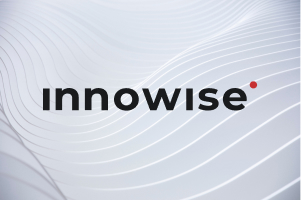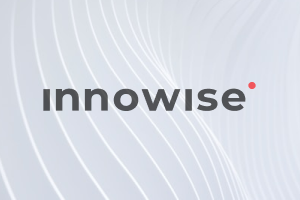Su mensaje ha sido enviado.
Procesaremos su solicitud y nos pondremos en contacto con usted lo antes posible.
El formulario se ha enviado correctamente.
Encontrará más información en su buzón.

Seleccionar idioma

La externalización del desarrollo de SaaS puede parecer una decisión arriesgada. Por un lado, le ofrece acceso a talentos de primer nivel y una comercialización más rápida. Por otro, existen algunos riesgos: elegir al proveedor equivocado, enfrentarse a vulnerabilidades de seguridad o acabar con un producto que no se adapta al crecimiento de su empresa.
Contratar a un equipo interno puede parecer una apuesta más segura. Sin embargo, es costoso y lento. Necesitará especialistas en infraestructura en la nube, DevOps, seguridad y UI/UX.
La externalización, cuando se hace bien, ofrece flexibilidad y experiencia para crear un producto SaaS seguro y escalable. La clave está en elegir al socio adecuado.
Ahí es donde Innowise entra en juego, líder en Subcontratación del desarrollo de SaaS. Nosotros ayudamosa empresas de todo el mundo a crear soluciones SaaS de alto rendimiento y preparadas para el futuro.
Esta guía desglosa todo lo que necesita saber -desde encontrar un proveedor fiable hasta establecer una colaboración fluida- para que pueda externalizar con confianza el desarrollo de SaaS sin cometer errores costosos. Entremos en materia.
Crear un producto SaaS desde cero no es tarea fácil. Supone una enorme inversión de tiempo, dinero y esfuerzo, y hay mucho en juego.
Como he dicho antes, crear una solución fiable, escalable y segura no es fácil... ni barato. Por eso la subcontratación puede ser un camino más inteligente para obtener la experiencia que necesita sin los gastos generales de un equipo interno. Veamos por qué tiene sentido.
Hablemos de dinero, porque, seamos sinceros, suele ser la primera preocupación. Contratar a un equipo de desarrollo interno a tiempo completo no es sólo cuestión de pagar sueldos. Hay que tener en cuenta los costes de contratación, las prestaciones, el espacio de oficina (aunque sea a distancia, se necesita infraestructura), la formación y, lo más importante, la rotación. Los buenos desarrolladores no son baratos, y perder a uno a mitad de proyecto puede costarle meses de trabajo.
La subcontratación le permite acceder a una reserva mundial de talento donde los costes son significativamente más bajos. Por ejemplo, en Norteamérica y Europa Occidental, contratar a un desarrollador puede costar entre $50 y $300 por hora. En cambio, desarrolladores con la misma cualificación en regiones como Europa del Este o Latinoamérica suelen cobrar entre $25 y $199.
Para ponerlo en perspectiva, comparemos los costes de desarrollo internos y externos:
| Gastos | Equipo interno (EE.UU./Europa Occidental) | Equipo subcontratado (Europa del Este, América Latina, Asia) |
| Contratación | $15.000+ por promotor | $0 (gestionado por una empresa externa) |
| Salarios (Senior Dev) | $120.000-$180.000 al año | $40.000-$80.000 al año |
| Beneficios y gastos generales | 30-50% de salario | Mínimo o incluido en el contrato |
| Oficina y equipos | $5.000+ por empleado al año | $0 (equipos remotos) |
| Formación e incorporación | $5.000-$10.000 por desarrollo | $0 (expertos preseleccionados) |
| Coste total anual | $200.000+ por promotor | $50.000-$100.000 por promotor |
¿Cuál es la clave? El desarrollo interno puede ser 2-4 veces más caro que la externalización, en función de la ubicación y la complejidad del proyecto.
La externalización elimina estos gastos generales, lo que permite a las empresas centrar sus recursos en el crecimiento, el marketing y la captación de clientes en lugar de en los gastos de nómina.
Y no se trata sólo de salarios: la externalización puede reducir los costes totales de desarrollo. hasta 40% en comparación con los equipos internos.
Además, con la externalización, sólo paga por lo que necesita. Sin gastos generales, sin desarrolladores inactivos esperando tareas, solo pura productividad.
Contratar a un equipo completo y experto en SaaS no sólo es costoso, sino increíblemente difícil. A sólido equipo de desarrollo de SaaS requiere especialistas en arquitectura en la nube, DevOps, diseño UI/UX, seguridad y desarrollo backend. Encontrar todas estas competencias internamente es una auténtica pesadilla de contratación.
Mediante la externalización, obtendrá acceso instantáneo a expertos preevaluados especializados en soluciones SaaS.
Estos desarrolladores ya han creado y lanzado plataformas SaaS, lo que significa que aportan marcos de trabajo probados, mejores prácticas y conocimientos del sector. En lugar de reinventar la rueda, aplican metodologías de eficacia probada que permiten comercializar el producto más rápidamente.
Tanto si necesita unos pocos expertos como si necesita un equipo de desarrollo completo, puede ampliar su equipo sin esfuerzo.
La velocidad lo es todo en SaaS. Cuanto más tiempo esté en desarrollo su producto, más dinero gastará y más posibilidades tendrá de que un competidor le gane la partida.
La externalización acelera el desarrollo de tres formas fundamentales:
Las empresas que adoptan estrategias de externalización ágiles y ajustadas pueden reducir el plazo de comercialización hasta en 30%. Esto cambia las reglas del juego, sobre todo en los sectores más dinámicos.
Si está creando una empresa de SaaS, su prioridad debe ser el crecimiento, la captación de clientes y la estrategia de producto. - no depurando código o manejando configuraciones del servidor.
Piénselo: ¿Debe su director general preocuparse por el cumplimiento de la seguridad en la nube? Debe su equipo de administración de TI participar en las optimizaciones de las bases de datos? No. La externalización le permite delegar complejidades técnicaspara que su equipo interno pueda centrarse en el crecimiento del negocio, las ventas y la experiencia del cliente..
Externalizar no significa perder el control, sino dejar la ejecución en manos de especialistas mientras usted dirige la empresa en la dirección correcta.
La externalización le ofrece la flexibilidad de ampliar o reducir su equipo de desarrollo en función de la demanda. ¿Necesita más desarrolladores antes del lanzamiento? Fácil. ¿Necesita reducirlos durante las fases de mantenimiento? No hay problema.
La capacidad de adaptarse a cargas de trabajo fluctuantes es crucial, especialmente si está creando un producto SaaS que espera un rápido crecimiento de usuarios. Lo último que quieres es un equipo interno demasiado pequeño para los grandes proyectos y demasiado grande para los periodos lentos.
Lanzar un producto SaaS es un reto lleno de presión, y cada paso conlleva peligros potenciales:
Un buen socio de externalización mitiga estos riesgos aportando al proyecto una experiencia probada, conocimientos sobre el cumplimiento de la normativa de seguridad y flujos de trabajo ágiles. Ya han afrontado retos similares y saben cómo abordar de forma proactiva los posibles problemas antes de que se conviertan en costosos errores.
Por ejemplo, los fallos de seguridad de SaaS suelen deberse a errores de configuración y a malas prácticas de codificación, que pueden evitarse trabajando con desarrolladores experimentados que sigan las mejores prácticas de seguridad desde el primer día.
Externalizar el desarrollo de su SaaS no es tan sencillo como elegir un proveedor y esperar lo mejor. Para obtener los mejores resultados, necesita un enfoque estructurado que garantice que su proyecto se mantiene alineado con sus objetivos, se ejecuta sin problemas y, en última instancia, ofrece un producto de alta calidad.
Desglosemos el proceso paso a paso.
Antes de pensar siquiera en contratar a un socio externo, hay que tener las cosas claras. ¿Qué está construyendo exactamente? ¿Para quién? ¿Cómo evolucionará con el tiempo?
Empiece por responder a estas preguntas clave:

Una vez que tengas una visión clara de lo que necesitas, es hora de documentarlo todo en una RFP (Solicitud de Propuesta). Piensa en ella como si fuera el currículum de tu proyecto: indica a los posibles proveedores exactamente lo que estás buscando, lo que te garantiza atraer al talento adecuado.
Su solicitud de propuestas debe incluir:
Ahora viene el trabajo de detective. Con la RFP en la mano, es hora de investigar y encontrar los mejores socios de externalización. Pero, ¿por dónde empezar?
Dónde encontrar proveedores fiables de externalización SaaS
Puede empezar su búsqueda consultando plataformas de evaluación externas como Clutch y GoodFirms donde encontrará opiniones y clasificaciones verificadas de clientes. Tenlo en cuenta también:
Dicho esto, no todos los proveedores de externalización ofrecen el mismo nivel de servicio. En función de sus necesidades y presupuesto, puede considerar autónomos, agencias locales o empresas de desarrollo offshore. He aquí cómo se comparan:
| Criterios | Autónomos | Agencias locales | Empresas de desarrollo offshore |
| Coste | 💲 El más bajo, pero varía mucho | 💲💲💲Mayor debido a los salarios regionales. | 💲💲 Precios competitivos, inferiores a los de las agencias locales. |
| Experiencia | Mixto - depende del individuo | Gran experiencia en nichos específicos | Amplia experiencia en distintos sectores y tecnologías |
| Escalabilidad | Limitado: una persona o un equipo pequeño | Moderado: puede ampliarse, pero es costoso | Alta: puede ampliarse o reducirse rápidamente en función de las necesidades. |
| Fiabilidad | Riesgoso: puede abandonar el proyecto o retrasar las obras | Fiable pero caro | Fiabilidad con una gestión de proyectos estructurada |
| Seguridad y conformidad | Bajo - puede carecer de medidas de seguridad adecuadas | Moderada - se aplican normas de cumplimiento regionales | Alto nivel: los equipos experimentados siguen protocolos de seguridad estrictos |
| Lo mejor para | Proyectos pequeños y no críticos | Proyectos SaaS de tamaño medio con un alcance definido | Desarrollo de SaaS escalable a largo plazo con necesidades de seguridad y cumplimiento de normativas |
Factores a tener en cuenta en un socio de externalización de SaaS
Una vez que haya recopilado una lista de posibles proveedores, fíltrelos en función de:
Señales de alarma que hay que evitar al elegir un proveedor
Esté atento también a estas señales de advertencia. Por ejemplo, contratos poco claros. Si un proveedor se niega a ofrecer un contrato estructurado con hitos bien definidos, acuerdos de nivel de servicio y propiedad de la propiedad intelectual, es posible que no sea de fiar.
La falta de transparencia también es una señal de alarma. Los proveedores que evitan compartir estudios de casos, referencias de clientes o estructuras de precios claras podrían estar ocultando algo o exagerando su experiencia..
Lo mismo ocurre con bajos estándares de seguridad. Si un proveedor no sigue el cumplimiento de GDPR, HIPAA o PCI DSS, su plataforma SaaS podría estar en grave riesgo de violación de datos o problemas legales.
Si un proveedor afirma que puede crear un producto SaaS complejo en un tiempo récord, lo más probable es que esté escatimando en calidad. Prometer plazos excesivos es un gran no.
Y por último, mala comunicación. La lentitud de las respuestas, la vaguedad de las respuestas o la ausencia de un gestor de proyectos especializado pueden provocar desajustes y retrasos.
Cómo realizar las entrevistas iniciales
Una vez que haya reducido su lista, es hora de hablar. Concierta llamadas de descubrimiento con los posibles proveedores y hazles preguntas como:
Haga realidad su visión de SaaS con desarrolladores expertos
Para conocer en profundidad cómo la inteligencia empresarial y la experiencia en seguridad pueden reforzar su oferta de SaaS, considere consultar con Innowise..
Antes de comprometerse con un contrato a largo plazo, debe ver a su proveedor en acción. Un portafolio y testimonios elogiosos están muy bien, pero no te dicen cómo el equipo en realidad funciona en condiciones reales de proyecto. Por eso resultan útiles los talleres de proveedores o los proyectos piloto, que permiten probar la colaboración antes de realizar una inversión total.
Talleres: cómo sentir la colaboración
Un taller con el proveedor es una sesión breve y estructurada en la que usted describe su proyecto SaaS en detalle y ve cómo el proveedor analiza los requisitos, sugiere soluciones y cuestiona los supuestos. Es una forma estupenda de evaluar su:
Incluso un taller de un día puede revelar si el equipo es estratégico e innovador o simplemente otra fábrica de código.

Proyectos piloto: probar la ejecución real
Si el taller va bien, el siguiente paso es un proyecto piloto a pequeña escala: una prueba de trabajo de desarrollo real. En lugar de entregarles toda la plataforma SaaS desde el primer día, asígneles un único módulo, función o prueba técnica de concepto. Esto le ayudará a evaluar:
Consejo profesional: Elige un proyecto piloto que no sea de misión crítica, pero que siga siendo relevante para tu hoja de ruta de SaaS. De este modo, aunque las cosas no funcionen, no habrás perdido el tiempo con una función inútil.
¿Próximo paso? Finalizar el contrato y asegurarnos de que todo es legalmente impecable.
Llegados a este punto, ya ha evaluado al proveedor, comprobado sus conocimientos y decidido seguir adelante. Pero antes de escribir el código, necesita un contrato sólido - que proteja sus intereses, establezca expectativas claras y evite costosos malentendidos en el futuro.
Un contrato de externalización bien estructurado no se limita a la jerga jurídica: es una hoja de ruta para una colaboración fructífera y sin conflictos. Esto es lo que hay que incluir:
Consejo profesional: Si un proveedor se resiste a la transferencia de propiedad intelectual o al pago de hitos, reconsidérelo: son señales de alarma. Más información sobre acuerdos estructurados de externalización en Cómo funciona Innowise.
Incluso la mejor asociación de externalización puede fracasar sin una comunicación clara y coherente. Se necesita un sistema estructurado que garantice que todo el mundo se mantiene alineado, que los avances son transparentes y que los problemas se abordan con prontitud. He aquí cómo hacerlo bien:
Consejo profesional: Si un proveedor no tiene un plan de comunicación claro, espere retrasos, malas interpretaciones y pérdidas de tiempo. Establezca las expectativas por adelantado.
Una vez firmado el contrato, es hora de prepare a su proveedor para el éxito. Un proceso de incorporación sólido garantiza que tengan todo lo necesario para empezar a trabajar sin retrasos innecesarios.
Primero, conceder acceso a recursos clave. Comparta la documentación, las credenciales y los sistemas pertinentes para que el equipo pueda empezar a trabajar inmediatamente.
En segundo lugar, aclare su marca y su público. Proporcione información sobre sus usuarios objetivo, sus objetivos empresariales y el panorama competitivo para alinear las expectativas.
Por último, definir los flujos de trabajo y las funciones. Establezca quién es responsable de qué, cómo se compartirán las actualizaciones y las mejores formas de gestionar las aprobaciones y los comentarios.
Una vez que el desarrollo está en marcha, necesita visibilidad del progreso y la calidad para que todo vaya por buen camino. Las métricas adecuadas garantizan que su producto SaaS se desarrolle a tiempo, dentro del presupuesto y conforme a las normas.

Ningún proyecto está completamente libre de riesgos, pero anticiparse a los posibles escollos puede ahorrarle grandes quebraderos de cabeza en el futuro. La clave está en la detección temprana y la planificación de contingencias para mantener el desarrollo de SaaS en el buen camino.
Cuidado con el alcance. Cambiar los requisitos a mitad del desarrollo puede hacer descarrilar los plazos y los presupuestos. Defina claramente el alcance en el contrato y utilice protocolos de solicitud de cambios.
Intenta evitar retrasos y falta de comunicación. Las comprobaciones periódicas y los informes estructurados ayudan a detectar los cuellos de botella antes de que se conviertan en problemas graves.
Y, incluir planes de contingencia. Prevea tiempo de reserva para retrasos imprevistos y, en caso necesario, cuente con una estrategia de reserva para los miembros más importantes del equipo o para recursos adicionales.
Este es el momento de la verdad: su producto SaaS está casi listo, pero un lanzamiento apresurado sin las comprobaciones adecuadas puede provocar problemas de rendimiento, vulnerabilidades de seguridad y usuarios frustrados. Unas pruebas rigurosas, una infraestructura sólida y una estrategia de despliegue inteligente garantizan un lanzamiento sin problemas.
Primero, realice pruebas exhaustivas. Realiza pruebas funcionales, de rendimiento, de seguridad y de aceptación del usuario (UAT) para detectar y solucionar problemas antes del lanzamiento.
En segundo lugar, prepare la infraestructura de despliegue. Trabaje con su proveedor para configurar el alojamiento en la nube, el autoescalado y las herramientas de supervisión para garantizar el tiempo de actividad y la fiabilidad. Elegir la plataforma de nube adecuada es crucial. Puede ser AWS, Azure, Kubernetes o su solución en la nube interna, o el almacenamiento local..
Incluso con una infraestructura sólida, la supervisión en tiempo real es esencial tras el lanzamiento. Herramientas como New Relic (seguimiento del rendimiento), Datadog (supervisión de la nube) y Sentry (detección de errores) ayudan a detectar y resolver problemas antes de que afecten a los usuarios.
Utilice una estrategia de despliegue inteligente. En lugar de lanzamientos arriesgados de una sola vez, opte por:
Por último, forme a su equipo y documente los procesos para garantizar una transferencia de conocimientos fluida. Una documentación bien estructurada ayuda a su personal interno a comprender cómo utilizar, gestionar y dar soporte al producto eficazmente. Esto facilita la incorporación de nuevos miembros al equipo y garantiza una gestión coherente de los productos en todos los ámbitos.
El lanzamiento de su producto SaaS no es la línea de meta, es sólo el principio. Mantenimiento y mejoras continuas son esenciales para mantener su plataforma segura, eficiente y competitiva. Sin un sólido plan de soporte posterior al lanzamiento, los errores, las vulnerabilidades de seguridad y las funciones obsoletas pueden erosionar rápidamente la confianza de los usuarios.
Para garantizar el éxito a largo plazo, asegúrese de que su proveedor le ofrece:
Su producto SaaS ya está en marcha, pero ¿cómo sabe si ha tenido éxito? La optimización posterior al lanzamiento es tan importante como el desarrollo. Realizar un seguimiento periódico de las métricas clave le ayudará a ajustar el rendimiento, mejorar la experiencia del usuario y maximizar los ingresos.
En primer lugar, supervise compromiso y retención de los usuarios. Los datos sobre inscripciones, tasa de abandono y uso de funciones le ayudarán a comprender cómo interactúan los clientes con su plataforma.
Por supuesto, también es necesario calcular el ROI y el crecimiento de los ingresos. Realice un seguimiento de las tasas de suscripción, el valor del ciclo de vida del cliente (CLV) y los costes de adquisición para garantizar la rentabilidad.
Por fin, evaluar la escalabilidad y el rendimiento. Pruebe cómo su sistema gestiona el aumento de tráfico, asegurándose de que sigue siendo rápido y estable a medida que crece la demanda.
Consejo profesional: Utilice las pruebas A/B, las herramientas de análisis y los bucles de comentarios de los clientes para realizar mejoras basadas en datos y mantener la competitividad de su SaaS.
Con todo en su sitio, ha externalizado y lanzado con éxito su producto SaaS, pero el viaje no termina aquí. La iteración y el crecimiento continuos son lo que hace prosperar un negocio SaaS.
Incluso con una sólida estrategia de subcontratación, el éxito no consiste sólo en elegir al proveedor adecuado, sino en tomar decisiones informadas en cada fase. Estas son algunas de las mejores prácticas clave para garantizar que el desarrollo de SaaS funcione sin problemas y ofrezca un valor empresarial real.
Un producto SaaS sólido no consiste sólo en grandes características, sino en resolver el problema adecuado para los usuarios adecuados. Antes de externalizar el desarrollo, asegúrate de tener una visión bien definida y basada en las necesidades reales de los usuarios.
Empiece por determinar quién es su público objetivo y a qué retos concretos se enfrenta.
No dé por sentado que sabe lo que quieren los usuarios - validarlo todo con datos. Las mejores empresas de SaaS iteran basándose en el comportamiento de los usuarios, no sólo en su intuición.
Realice entrevistas con clientes, estudios de la competencia y análisis de comportamiento para descubrir los puntos débiles y validar la demanda. Comprender a los usuarios ayuda a perfeccionar el conjunto de funciones, las expectativas de usabilidad y la estrategia de precios, garantizando que los esfuerzos de desarrollo se ajusten a las necesidades reales del mercado y no a suposiciones.
Una vez que tenga claro el perfil de su audiencia, defina sus características principales, objetivos de escalabilidad y requisitos de cumplimiento (por ejemplo, GDPR, HIPAA). También es importante distinguir entre las funcionalidades imprescindibles y las que no lo son tanto. De este modo, su socio de externalización de SaaS dispondrá de la flexibilidad necesaria para optimizar el desarrollo y garantizar el cumplimiento de sus objetivos empresariales esenciales.
Consejo profesional: Definir una "no negociable frente a flexible" para sus requisitos. Describa claramente qué funciones, parámetros de rendimiento y necesidades de cumplimiento son imprescindibles y cuáles son opcionales o iterativas.
Esto ayuda a los proveedores a priorizar el desarrollo y evitar retrasos innecesarios, al tiempo que garantiza el cumplimiento de sus objetivos principales. De este modo, evitarás que se desplace el alcance, agilizarás la toma de decisiones y te asegurarás de que, aunque sea necesario hacer ajustes, la visión central del producto permanezca intacta.
El desarrollo de SaaS no es un proceso de un solo paso: requiere retroalimentación continua, mejoras graduales y adaptabilidad a la evolución de las necesidades de los usuarios.
Por eso el desarrollo ágil es el enfoque preferido para la externalización de SaaS. En lugar de esperar meses a tener un producto totalmente creado, Agile garantiza que las características se publiquen en iteraciones, lo que permite una comercialización más rápida y mejoras continuas basadas en los comentarios reales de los usuarios..
Para que Agile funcione eficazmente con su socio de externalización, asegúrese de que:
Consejo profesional: Un proveedor reacio a los métodos ágiles podría no ser el más adecuado para un producto SaaS en rápida evolución.
Al externalizar el desarrollo de SaaS, la propiedad del código, los datos y los diseños no debe ser negociable. Antes de firmar un contrato, aclara estos puntos clave:
Consejo profesional: Algunos proveedores retienen derechos parciales para reutilizar el código: asegúrese de que su contrato lo impide. Define claramente las cláusulas de exclusividad para evitar que tu producto SaaS sea reutilizado por la competencia.

El éxito de una relación de externalización va más allá de la mera entrega de un producto: se trata de construir una colaboración fiable y a largo plazo. Para conseguirlo:
Consejo profesional: Involucre a su proveedor en los debates empresariales clave, las sesiones de comentarios de los clientes y las hojas de ruta de los productos. Cuanto mejor entienda su visión, más eficaz será a la hora de ofrecer una solución escalable y preparada para el futuro.
“He visto a demasiadas empresas precipitarse hacia la subcontratación sólo para ahorrar costes, sólo para acabar con un producto que no cumple sus expectativas. La clave está en encontrar un socio que entienda de verdad sus objetivos, no sólo uno que codifique lo que pone en la hoja de especificaciones. Cuando tratas a tu equipo de subcontratación como a uno más, es cuando se produce la verdadera innovación.“

Dmitry Nazarevich
CTO de Innowise
El lanzamiento de su producto SaaS es sólo el principio: el éxito viene de las mejoras continuas. Manténgase a la vanguardia:
Consejo profesional: El éxito de SaaS no consiste en lanzar rápido, sino en iterar basándose en datos reales. Los mejores productos evolucionan continuamente para satisfacer las demandas de los usuarios y las tendencias del mercado.
Cuando externalice SaaS, necesitará un socio con amplia experiencia, un historial probado y el compromiso de ofrecer soluciones escalables y de alto rendimiento.
Innowise trae 18 años de experiencia en desarrollo de software y ofrece servicios de externalización del desarrollo de SaaS de extremo a extremo, desde la validación de la idea hasta el lanzamiento y la asistencia posterior.
Con un equipo personalizado de desarrolladores, diseñadores, analistas y gestores de proyectos, nos aseguramos de que cada proyecto se ajuste a los objetivos empresariales y a los requisitos técnicos.
Habiendo entregado con éxito más de 500 proyectos, Innowise se especializa en la creación de arquitecturas multiinquilino, soluciones nativas en la nube y plataformas SaaS seguras y potenciadas por IA.
Nuestra experiencia se extiende a diversos sectores, como la tecnología financiera, la sanidad y la automatización empresarial. Descubra Casos prácticos de SaaS para ver cómo hemos ayudado a las empresas a crear y ampliar productos SaaS innovadores.
Tanto si empieza desde cero como si optimiza una plataforma existente, Servicios de externalización de Innowise ofrecen la flexibilidad, fiabilidad y experiencia necesarias para hacer realidad su visión.












Su mensaje ha sido enviado.
Procesaremos su solicitud y nos pondremos en contacto con usted lo antes posible.

Al registrarse, acepta nuestra Política de privacidadincluyendo el uso de cookies y la transferencia de su información personal.